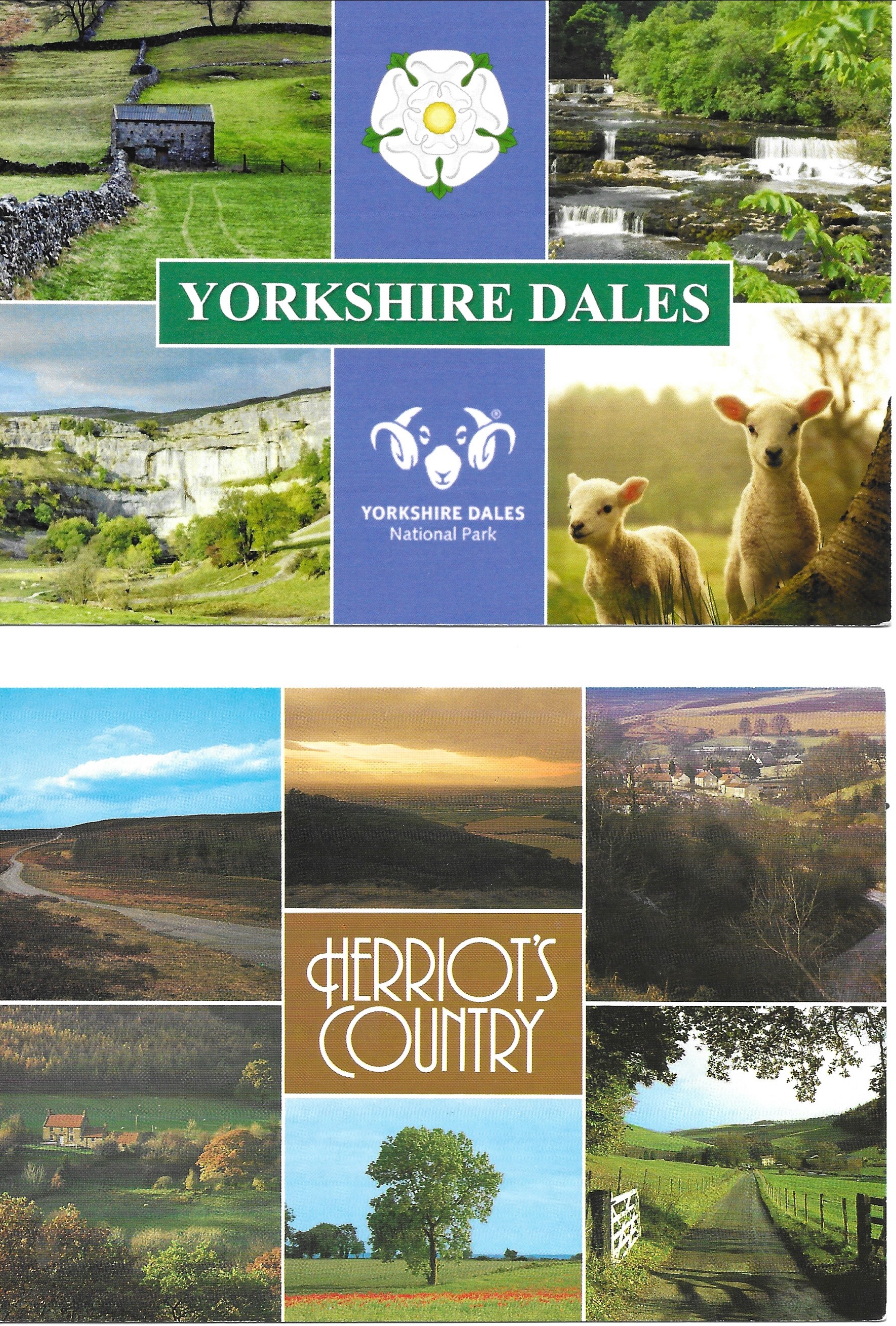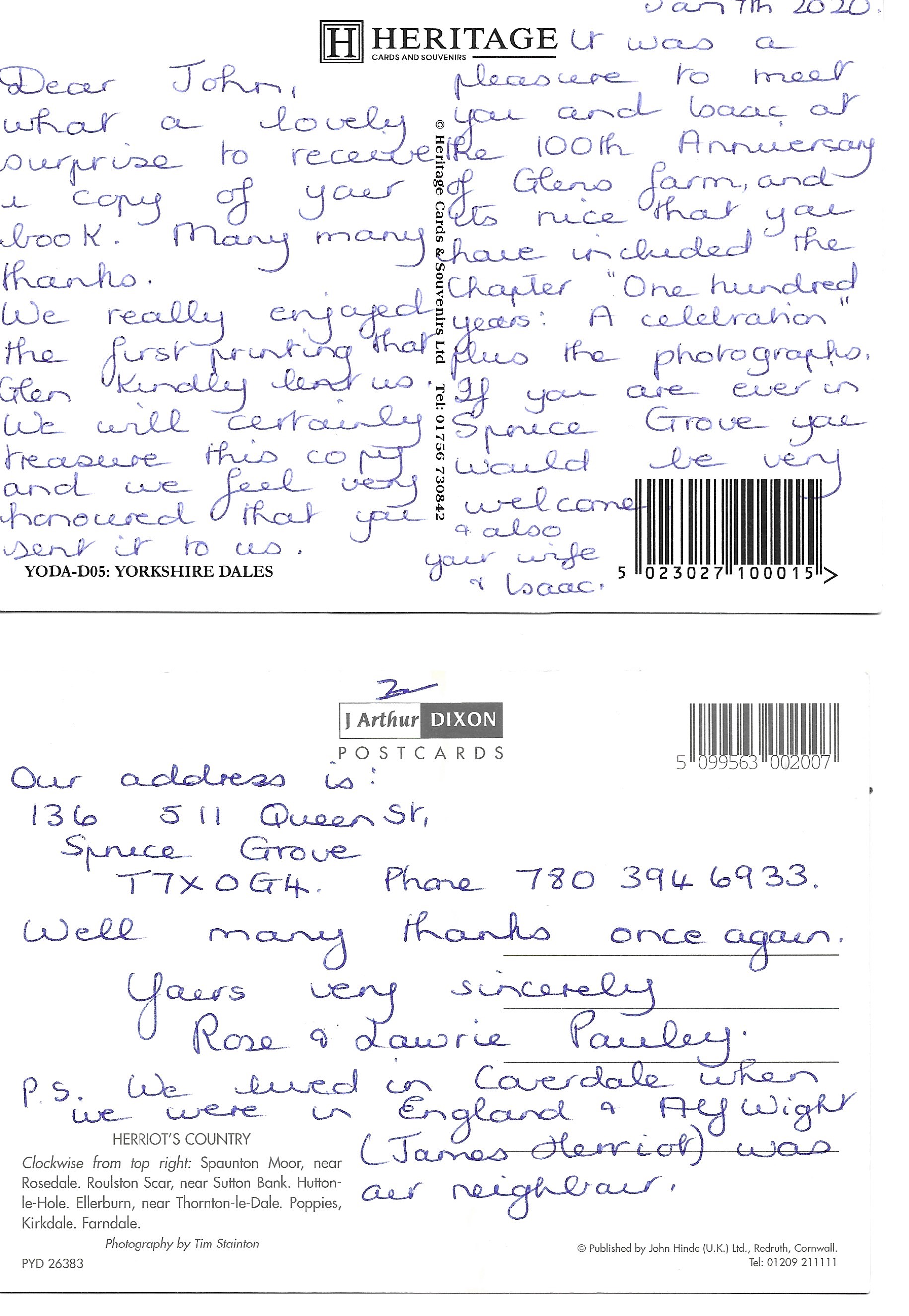|
CHURCH AND CUSTOMS
The hired man's house
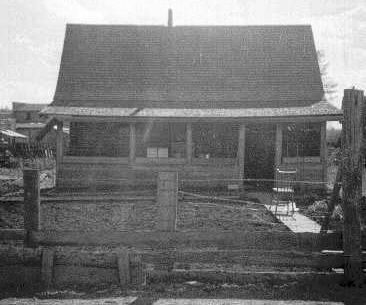 After six weeks or so the hired man's house was ready. It was not a modern house! No running water but there was electricity. On the main floor there were three rooms, and upstairs, perhaps one. The kitchen was the first room you entered: the stove was the first thing noted. There where no washroom facilities. The comfort station was outside; correct toilet paper was quickly installed. In England I had lived in a three-bed roomed home, built in 1937. It had running water, electricity, was heated and had a full washroom with a bath. I figured I had moved backwards by some 100 hundred years. But press on! Immigrants cannot be choosers. After six weeks or so the hired man's house was ready. It was not a modern house! No running water but there was electricity. On the main floor there were three rooms, and upstairs, perhaps one. The kitchen was the first room you entered: the stove was the first thing noted. There where no washroom facilities. The comfort station was outside; correct toilet paper was quickly installed. In England I had lived in a three-bed roomed home, built in 1937. It had running water, electricity, was heated and had a full washroom with a bath. I figured I had moved backwards by some 100 hundred years. But press on! Immigrants cannot be choosers.
I'm not sure if my boss really understood what I was experiencing:in one conversation he said (I was never quite sure when Fred was kidding or not!) he had met English people who believed milk came from cans. What udder (!) nonsense. I don't think he could appreciate that I had come from a village where I was five minutes from the stores (shops), with paved roads, mail came every day, every home had running water et al. I have to say, though, without reservation, that the whole family treated me very kindly.
[Re: Fred understanding where I was at: Of course he knew!]
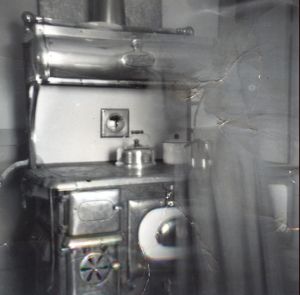 The 'stove': The ghostly figure in the photograph could well be the author's wife: the stove haunted her, perhaps she is getting her own back!Back to the stove; no turning on a switch for the heat to come on, it had to be fired up, a task that I took on because, no heat, no tea, and no warm (?) water to wash in! I had no electrical appliances. The stove was replaced with one from Eaton's; but it was not used often as our farming days were about over. The 'stove': The ghostly figure in the photograph could well be the author's wife: the stove haunted her, perhaps she is getting her own back!Back to the stove; no turning on a switch for the heat to come on, it had to be fired up, a task that I took on because, no heat, no tea, and no warm (?) water to wash in! I had no electrical appliances. The stove was replaced with one from Eaton's; but it was not used often as our farming days were about over.
Groceries
In order to get Groceries or letters mailed I would leave a list and the letters in a slot in the office; I could not understand why I did not get the groceries right away: it was not until later I learned the nearest grocery store was about a mile away; daily visits were not the norm. It's not that I was ungrateful, it was simply I was not a Canadian and most definitely not a rural Canadian! I remember one trip to Edmonton where I stocked up on groceries, at Avenue Trading on 118 Avenue. I had a steady diet of tinned meat (spam?) golden wax beans and prune plums, items never on my menu now.
[The Greenhough Brothers operated a International Harvester dealership: I had nothing to with that operation.
Glen later told me the store was four and one half miles away]
Thorsby Movie House
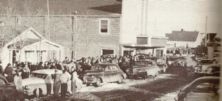 The photograph shows the movie house circa 1951. Harvey Greenhough asked if I would like to go to a movie? Would I like to go to a movie!!!! I dressed as if I were in England, (hey, no one told me what to wear!) suit, tie, and shiny shoes. Thorsby in 1957 had no paved streets or sidewalks. Ah well, it gave the locals a bit of a laugh! Don't remember the film. The photograph shows the movie house circa 1951. Harvey Greenhough asked if I would like to go to a movie? Would I like to go to a movie!!!! I dressed as if I were in England, (hey, no one told me what to wear!) suit, tie, and shiny shoes. Thorsby in 1957 had no paved streets or sidewalks. Ah well, it gave the locals a bit of a laugh! Don't remember the film.
Tried popcorn for the first time, not impressed, have a better opinion of it now! After the show I was taken to a café, I must have stood out like a sore thumb. After coffee Donnie Greenhough, and some friends took me for a ride to see an oil well. I distinctly remember the speedometer of the car, the Buick, reading 90 mph as we drove over dirt roads. I viewed my first oil derrick at 2.00 a.m. I was glad to get home.
Over populated?
It was on the way to the movies that Harvey, who was driving the truck, remarked how over-crowded the area was growing. I was amazed, it seemed I did not see a house forever. If I had known then about such things as quarter sections I would have understood. However, even in 2009 that part of the County could not be described as over populated
[ In the early 2000's I worked in Leduc County: I did not consider the County over populated. IN fact I could drive a secondary highway forever and never see a soul!]
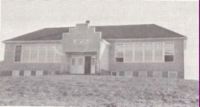
Genesee School
From their treatment of me it was obvious that the Fred Greenhoughs were Christians (at least we had that in common). They had invited me to a prayer meeting held in their home, grace was said before every meal. I attended church, which was held in the Genesee School. A Rev. Hutchinson was the minister; he was a circuit preacher with churches at Genesee, Warburg and Telfordville and Breton. Warburg United Church.
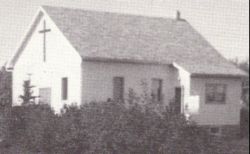 Warburg United Church On Good Friday 1957 I attended the inaugural service of the new or reconstructed Warburg United Church, shown in the picture to the left. . The minister was still nailing the cross to the wall as I entered: Very meaningful for that time of the year to those who believe. Warburg United Church On Good Friday 1957 I attended the inaugural service of the new or reconstructed Warburg United Church, shown in the picture to the left. . The minister was still nailing the cross to the wall as I entered: Very meaningful for that time of the year to those who believe.
I also attended the (re)-opening of the Rundle Mission at Pigeon Lake. The Buick became stuck in the mud and I learned the 'sit on the hood' method as opposed to the 'push from behind' process. The 'it on the hood' seemed to succeed.
[The photo of Rundle Mission proved by Colleen Lomas, manager of the Mission.]
Strange custom: To us!
In England you have to be properly introduced before one dines with a stranger, I learned it is not so in Genesee! I had ordered a bag of potatoes; they were duly delivered around noon. The man put the potatoes down but lingered unduly at the door, and he lingered even longer, so long in fact that it struck me as very strange! He did eventually leave, I mentioned it to Fred; he said the man was waiting to be invited in for lunch, it was his pattern. Strange but true!
Tractors
A garden surrounded Fred's home on three sides; Fred was tilling the soil using a tractor , his wife said he looked like a monkey on a peanut. As a guest I was not sure whether to laugh or remain silent, I chose the latter even if the remark seemed appropriate. It was a very small tractor!
Speaking of tractors : I drove the same small tractor around the yard. I enhanced my 'backing up with a trailer' skills. On one occasion I tried to change gears going up a hill just outside the Greenhough enclave. The front wheels came up in an alarming manner. I had visions of being a crushed peanut under a tractor! Again, although I never actually operated the auger to move wheat, I was warned of the dangers of this piece of equipment close to loose clothing, particularly if you positioned yourself so that the groin area was too close. There was at least one dramatic story that may or may not have been true! It was with some surprise that I learned many years later Harvey had been injured using the machinery.
Sounds of Music
 I had left my relatives at the immigration hall without telling them where I was going. It was six weeks before I saw them again. They brought a small radio with them, without a tuning dial. It was stuck on 6.30 CHED, which was a music(?) channel. I learned stereo sound was being introduced: To get the affect of this new invention one needed two radios, which if played simultaneously, on the same station, of course, they would produce stereophonic sound. I was unable to carry out this experiment. I only had one radio! Some tunes coming to mind for that period are, 'A White Coat and a Pink Carnation', 'A Slow Boat to China', 'The Shrimps Boats are Coming' and 'So Rare'. I had left my relatives at the immigration hall without telling them where I was going. It was six weeks before I saw them again. They brought a small radio with them, without a tuning dial. It was stuck on 6.30 CHED, which was a music(?) channel. I learned stereo sound was being introduced: To get the affect of this new invention one needed two radios, which if played simultaneously, on the same station, of course, they would produce stereophonic sound. I was unable to carry out this experiment. I only had one radio! Some tunes coming to mind for that period are, 'A White Coat and a Pink Carnation', 'A Slow Boat to China', 'The Shrimps Boats are Coming' and 'So Rare'.
Farrowing
Another first at Genesee was actually seeing a sow (or any other animal or human) give birth to piglets. The piglets were thrust from the sow at what seemed great force and with repeated regularity. The sow seemed most disinterested in the whole proceedings. Glen had warned me, about sows with a litter so I took no chances when I later entered the sty.
Veterinarians? Methinks not!
Glen had noticed a sow wandering loose with the others in the yard; it had an infected side. The plan was to corral the sow; cut the swelling in order to release what we guessed was be pus inside. Our herding efforts went un-rewarded but in the process the sow must have knocked against something; the wound opened and was on its way to being cleansed. We kept a careful eye on the sow for some time to ensure the healing process took place. Glen and I were relieved at the self-induced treatment.
Dreaming
It took next to no time to realize I was not intended for farming life. (I'm sure the Greenhoughs must have realized this as well although they continued to treat me well). So July 1957 saw me headed for the big City. The stove I had purchased arrived sometime later and was sold to a person to use in their cottage.
The Big City
This story is not about Edmonton; suffice it to say the good Lord was kind to me. I first worked in a warehouse, then moved to the City Police (remember Stallknecht, Maday and Hobbs) After 18 years in the Police I moved to the first of several management positions before retiring in 1994. Genesee was far from my mind. But then I finished up at a Noxious Weed Seminar in Genesee, there I met one of the Greenhough daughter's, I hired an Australian fellow who had worked for a Greenhough.
Assistant Development Officer
My youngest daughter, a legal secretary, heard a bylaw enforcement officer was needed in Fort Saskatchewan; this turned out to be that an assistant development officer was wanted in the then County of Leduc! I was hired and had to find my way around with a map that only gave legal descriptions. I always took my lunch when I went on my visits! Being hired was very much like when Mr. Fred Greenhough first hired me. I knew a fair bit about (some) bylaws and had supervised people in bylaw enforcement. It is a real test of your skills when you have to actually carry out investigations, based on what you had taught others to do!
The Power Plant
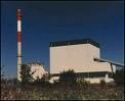 I won't mention the names of the people I worked with and for in the County, but I will say, unreservedly, they treated me with great respect (age will do that!). They told me about short cuts, what to watch for when entering a farmyard (dogs) and that Leduc people are fine to deal with and, for the most part this turned out to be true. I won't mention the names of the people I worked with and for in the County, but I will say, unreservedly, they treated me with great respect (age will do that!). They told me about short cuts, what to watch for when entering a farmyard (dogs) and that Leduc people are fine to deal with and, for the most part this turned out to be true.
With my hiring, a new era was beginning. There had been development officers prior to me; however, much of the enforcement work had been done by 'word of mouth'. My city training had taught me there needed to be a written accounting of visits and responses from the citizens. I do believe I achieved a modicum of success. Folks in the County are no different than city folk when it comes to following the rules, 90% or higher simply do as they are asked. Of the remaining 10% about 7.5% do conform with some harder work. The remainder is best not mentioned.
Genesee did not cause me any undue concerns: The only Genesee files I recall were the power plant and St. John's School which were dealt with through telephone calls. After 7 years I retired (again) and left on good terms with the staff and most of the people I had dealt with.
[One file I dealt with related to the Power Plant, George Greenhough had something to with the landscaping!]
I have been dealt fairly by the folks in the County and more so by the Greenhoughs! Genesee will always bring fond memories.
|
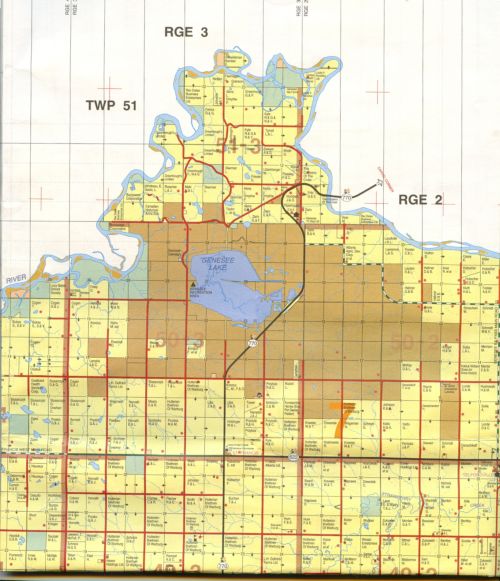
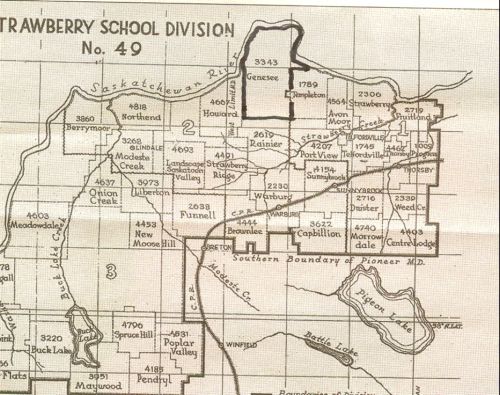
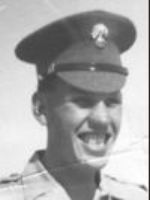
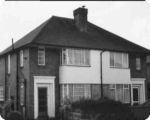
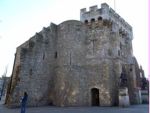
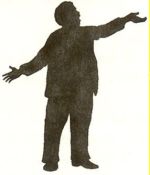 Immigrants!? It is fair to say those arriving in Canada in 1957 did not consider themselves 'immigrants'. The word did and does have bad connotations. We considered ourselves as New Canadians coming to find a better life. And, of course, being British coming to the 'colonies', we had much to offer! (which we did of course!). I admit with some pride, I am now a Canadian citizen, and have been for over thirty years.
Immigrants!? It is fair to say those arriving in Canada in 1957 did not consider themselves 'immigrants'. The word did and does have bad connotations. We considered ourselves as New Canadians coming to find a better life. And, of course, being British coming to the 'colonies', we had much to offer! (which we did of course!). I admit with some pride, I am now a Canadian citizen, and have been for over thirty years.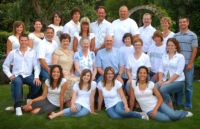 My family has grown somewhat now consisting of two English born parents, two biological children (true Canadians?), two adopted children, one French-Canadian the other of English-Ukrainian heritage. Marriage, through our children, has added an African-Cherokee husband, a Canadian-Finnish-English husband, a German-Canadian husband, Canadian-French wife, a Chinese-Canadian-English husband for a granddaughter, plus Canadian-German husband and two other granddaughters are courting lads from Central America.
My family has grown somewhat now consisting of two English born parents, two biological children (true Canadians?), two adopted children, one French-Canadian the other of English-Ukrainian heritage. Marriage, through our children, has added an African-Cherokee husband, a Canadian-Finnish-English husband, a German-Canadian husband, Canadian-French wife, a Chinese-Canadian-English husband for a granddaughter, plus Canadian-German husband and two other granddaughters are courting lads from Central America.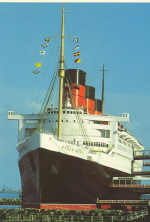 How an English chap started working on an Alberta farm is not complicated, but it is different and worthy of being preserved, in my humble opinion! The years prior to 1957 and the trip to Canada had been interesting. I had in 1956, I completed three years with the Grenadier Guards; I was released in April but recalled in August for the Suez Canal crisis. I was shipped to Malta. I was engaged to be married. I moved from Malta to Egypt and then to Cyprus where I quickly began to read accumulated mail. Gadzooks, she's moving to Canada, Mum, Dad family and all,and no, they could not wait until I came home. It's December. Between December and February I come home, get married and with my wife and her family am booked on a ship for Canada. The ship trip across, in the 'Scythia', was our honeymoon.
How an English chap started working on an Alberta farm is not complicated, but it is different and worthy of being preserved, in my humble opinion! The years prior to 1957 and the trip to Canada had been interesting. I had in 1956, I completed three years with the Grenadier Guards; I was released in April but recalled in August for the Suez Canal crisis. I was shipped to Malta. I was engaged to be married. I moved from Malta to Egypt and then to Cyprus where I quickly began to read accumulated mail. Gadzooks, she's moving to Canada, Mum, Dad family and all,and no, they could not wait until I came home. It's December. Between December and February I come home, get married and with my wife and her family am booked on a ship for Canada. The ship trip across, in the 'Scythia', was our honeymoon.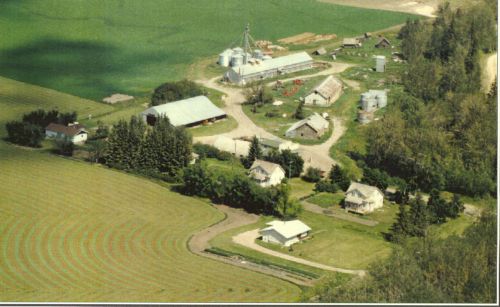 The Greenhough Spread, circa 1995
The Greenhough Spread, circa 1995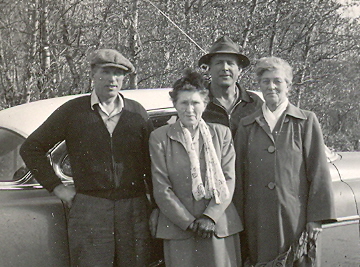

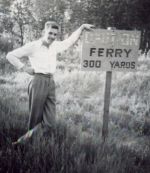
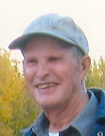
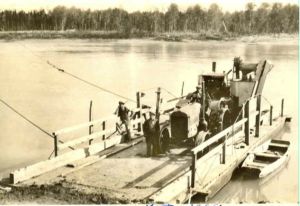 was left high and dry far out of the water; in 1946 a sudden cold spell in the fall caused an ice jam resulting in much strain being put on the main cable, and the danger of toppling the towers was relieved only by cutting the lead cables with a cutting torch.[The photo shows the combine bought by the Greenhoughs and the first in Western Canada, photo courtesy of Glen Greenhough]
was left high and dry far out of the water; in 1946 a sudden cold spell in the fall caused an ice jam resulting in much strain being put on the main cable, and the danger of toppling the towers was relieved only by cutting the lead cables with a cutting torch.[The photo shows the combine bought by the Greenhoughs and the first in Western Canada, photo courtesy of Glen Greenhough]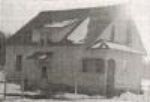 Their home was quite modern, and to me, quite large. All meals I ate were in the kitchen. Each meal was preceded with a grace: "Be present at our table Lord, Be here and everywhere adored, with mercies bless and grant that we, may feast in paradise with thee"! I was treated as one of the family.
Their home was quite modern, and to me, quite large. All meals I ate were in the kitchen. Each meal was preceded with a grace: "Be present at our table Lord, Be here and everywhere adored, with mercies bless and grant that we, may feast in paradise with thee"! I was treated as one of the family.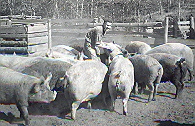 Glen, Fred's son, was my instructor and from him I was taught all that needed to be taught. I was taken to the pig barn where the pigs scheduled for market were housed. The mixing of the food took place in a cart; I suppose 18 inches by 36 inches, on wheels. The food was poured from a sack into the container and water added: stirred with a small spade. Glen could not produce an exact recipe: I had to watch the stools of the pigs and if they were too liquid then something had to be reduced or was that increased? Fifty years gone by does not aid the memory! The cart was wheeled so that the mixture could be placed so as to feed the pigs. Fred talked of designing a feeding system where dry feed would be used; two angle iron bars would be welded together; secured at either end to a mechanism that would rotate and allow feed to fall into the trough.
Glen, Fred's son, was my instructor and from him I was taught all that needed to be taught. I was taken to the pig barn where the pigs scheduled for market were housed. The mixing of the food took place in a cart; I suppose 18 inches by 36 inches, on wheels. The food was poured from a sack into the container and water added: stirred with a small spade. Glen could not produce an exact recipe: I had to watch the stools of the pigs and if they were too liquid then something had to be reduced or was that increased? Fifty years gone by does not aid the memory! The cart was wheeled so that the mixture could be placed so as to feed the pigs. Fred talked of designing a feeding system where dry feed would be used; two angle iron bars would be welded together; secured at either end to a mechanism that would rotate and allow feed to fall into the trough. After six weeks or so the hired man's house was ready. It was not a modern house! No running water but there was electricity. On the main floor there were three rooms, and upstairs, perhaps one. The kitchen was the first room you entered: the stove was the first thing noted. There where no washroom facilities. The comfort station was outside; correct toilet paper was quickly installed. In England I had lived in a three-bed roomed home, built in 1937. It had running water, electricity, was heated and had a full washroom with a bath. I figured I had moved backwards by some 100 hundred years. But press on! Immigrants cannot be choosers.
After six weeks or so the hired man's house was ready. It was not a modern house! No running water but there was electricity. On the main floor there were three rooms, and upstairs, perhaps one. The kitchen was the first room you entered: the stove was the first thing noted. There where no washroom facilities. The comfort station was outside; correct toilet paper was quickly installed. In England I had lived in a three-bed roomed home, built in 1937. It had running water, electricity, was heated and had a full washroom with a bath. I figured I had moved backwards by some 100 hundred years. But press on! Immigrants cannot be choosers. The 'stove': The ghostly figure in the photograph could well be the author's wife: the stove haunted her, perhaps she is getting her own back!Back to the stove; no turning on a switch for the heat to come on, it had to be fired up, a task that I took on because, no heat, no tea, and no warm (?) water to wash in! I had no electrical appliances. The stove was replaced with one from Eaton's; but it was not used often as our farming days were about over.
The 'stove': The ghostly figure in the photograph could well be the author's wife: the stove haunted her, perhaps she is getting her own back!Back to the stove; no turning on a switch for the heat to come on, it had to be fired up, a task that I took on because, no heat, no tea, and no warm (?) water to wash in! I had no electrical appliances. The stove was replaced with one from Eaton's; but it was not used often as our farming days were about over. The photograph shows the movie house circa 1951. Harvey Greenhough asked if I would like to go to a movie? Would I like to go to a movie!!!! I dressed as if I were in England, (hey, no one told me what to wear!) suit, tie, and shiny shoes. Thorsby in 1957 had no paved streets or sidewalks. Ah well, it gave the locals a bit of a laugh! Don't remember the film.
The photograph shows the movie house circa 1951. Harvey Greenhough asked if I would like to go to a movie? Would I like to go to a movie!!!! I dressed as if I were in England, (hey, no one told me what to wear!) suit, tie, and shiny shoes. Thorsby in 1957 had no paved streets or sidewalks. Ah well, it gave the locals a bit of a laugh! Don't remember the film.
 Warburg United Church On Good Friday 1957 I attended the inaugural service of the new or reconstructed Warburg United Church, shown in the picture to the left. . The minister was still nailing the cross to the wall as I entered: Very meaningful for that time of the year to those who believe.
Warburg United Church On Good Friday 1957 I attended the inaugural service of the new or reconstructed Warburg United Church, shown in the picture to the left. . The minister was still nailing the cross to the wall as I entered: Very meaningful for that time of the year to those who believe. I had left my relatives at the immigration hall without telling them where I was going. It was six weeks before I saw them again. They brought a small radio with them, without a tuning dial. It was stuck on 6.30 CHED, which was a music(?) channel. I learned stereo sound was being introduced: To get the affect of this new invention one needed two radios, which if played simultaneously, on the same station, of course, they would produce stereophonic sound. I was unable to carry out this experiment. I only had one radio! Some tunes coming to mind for that period are, 'A White Coat and a Pink Carnation', 'A Slow Boat to China', 'The Shrimps Boats are Coming' and 'So Rare'.
I had left my relatives at the immigration hall without telling them where I was going. It was six weeks before I saw them again. They brought a small radio with them, without a tuning dial. It was stuck on 6.30 CHED, which was a music(?) channel. I learned stereo sound was being introduced: To get the affect of this new invention one needed two radios, which if played simultaneously, on the same station, of course, they would produce stereophonic sound. I was unable to carry out this experiment. I only had one radio! Some tunes coming to mind for that period are, 'A White Coat and a Pink Carnation', 'A Slow Boat to China', 'The Shrimps Boats are Coming' and 'So Rare'. I won't mention the names of the people I worked with and for in the County, but I will say, unreservedly, they treated me with great respect (age will do that!). They told me about short cuts, what to watch for when entering a farmyard (dogs) and that Leduc people are fine to deal with and, for the most part this turned out to be true.
I won't mention the names of the people I worked with and for in the County, but I will say, unreservedly, they treated me with great respect (age will do that!). They told me about short cuts, what to watch for when entering a farmyard (dogs) and that Leduc people are fine to deal with and, for the most part this turned out to be true.